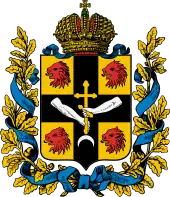Gori uezd
Горійскій уѣздъ | |
|---|---|
 Coat of arms | |
 Location in the Tiflis Governorate | |
| Country | Russian Empire |
| Viceroyalty | Caucasus |
| Governorate | Tiflis |
| Established | 1801 |
| Abolished | 1930 |
| Capital | Gori |
| Area | |
| • Total | 6,836.98 km2 (2,639.77 sq mi) |
| Population (1916) | |
| • Total | 241,016 |
| • Density | 35/km2 (91/sq mi) |
| • Urban | 7.66% |
| • Rural | 92.34% |
The Gori uezd[lower-alpha 1] was a county (uezd) of the Tiflis Governorate of the Caucasus Viceroyalty of the Russian Empire, and then of Democratic Republic of Georgia, with its administrative center in Gori.[1] The area of the county roughly corresponded to the contemporary Shida Kartli region of Georgia.
History
Following the Russian Revolution, the Gori uezd was incorporated into the short-lived Democratic Republic of Georgia.[1]
Administrative divisions
The subcounties (uchastoks) of the Gori uezd in 1913 were as follows:[2]
| Name | 1912 population |
|---|---|
| Akhalkalakskiy uchastok (Ахалкалакскій участокъ) | 27,765 |
| Borzhomskiy uchastok (Боржомскій участокъ) | 9,284 |
| Gomskiy uchastok (Гомскій участокъ) | 19,868 |
| Gorno-Osetinskiy uchastok (Горио-Осетинскій участокъ) | 23,933 |
| Karelskiy uchastok (Карельскій участокъ) | 22,982 |
| Kvemo-Chalskiy uchastok (Квемо-Чалскій участокъ) | 14,216 |
| Medzhviskhevskiy uchastok (Меджвисхевскій участокъ) | 23,770 |
| Suramskiy uchastok (Сурамскій участокъ) | 12,351 |
| Tskhinvalskiy uchastok (Цхинвальскій участокъ) | 31,953 |
Demographics
Russian Empire Census
According to the Russian Empire Census, the Gori uezd had a population of 191,091 on 28 January [O.S. 15 January] 1897, including 102,837 men and 88,254 women. The majority of the population indicated Georgian to be their mother tongue, with a significant Ossetian speaking minority.[3]
| Language | Native speakers | % |
|---|---|---|
| Georgian | 124,180 | 64.98 |
| Ossetian | 50,036 | 26.18 |
| Armenian | 7,686 | 4.02 |
| Russian | 5,281 | 2.76 |
| Greek | 917 | 0.48 |
| Jewish | 874 | 0.46 |
| Tatar[lower-alpha 2] | 432 | 0.23 |
| Imeretian | 393 | 0.21 |
| Ukrainian | 335 | 0.18 |
| Mingrelian | 233 | 0.12 |
| Polish | 218 | 0.11 |
| German | 197 | 0.10 |
| Assyrian | 64 | 0.03 |
| Turkish | 38 | 0.02 |
| Avar-Andean | 30 | 0.02 |
| Czech | 20 | 0.01 |
| Dargin | 19 | 0.01 |
| Kyurin | 16 | 0.01 |
| Persian | 15 | 0.01 |
| Lithuanian | 14 | 0.01 |
| Latvian | 13 | 0.01 |
| Chechen | 12 | 0.01 |
| Belarusian | 7 | 0.00 |
| Romanian | 4 | 0.00 |
| Italian | 2 | 0.00 |
| Kurdish | 1 | 0.00 |
| Other | 54 | 0.03 |
| TOTAL | 191,091 | 100.00 |
Kavkazskiy kalendar
According to the 1917 publication of Kavkazskiy kalendar, the Gori uezd had a population of 241,016 on 14 January [O.S. 1 January] 1916, including 124,658 men and 116,358 women, 226,436 of whom were the permanent population, and 14,580 were temporary residents:[6]
| Nationality | Urban | Rural | TOTAL | |||
|---|---|---|---|---|---|---|
| Number | % | Number | % | Number | % | |
| Georgians | 9,580 | 51.91 | 152,846 | 68.68 | 162,426 | 67.39 |
| North Caucasians | 0 | 0.00 | 37,567 | 16.88 | 37,567 | 15.59 |
| Armenians | 7,270 | 39.40 | 25,552 | 11.48 | 32,822 | 13.62 |
| Jews | 104 | 0.56 | 3,998 | 1.80 | 4,102 | 1.70 |
| Russians | 1,377 | 7.46 | 1,030 | 0.46 | 2,407 | 1.00 |
| Asiatic Christians | 0 | 0.00 | 1,450 | 0.65 | 1,450 | 0.60 |
| Shia Muslims[lower-alpha 3] | 22 | 0.12 | 116 | 0.05 | 138 | 0.06 |
| Other Europeans | 65 | 0.35 | 3 | 0.00 | 68 | 0.03 |
| Sunni Muslims[lower-alpha 4] | 36 | 0.20 | 0 | 0.00 | 36 | 0.01 |
| TOTAL | 18,454 | 100.00 | 222,562 | 100.00 | 241,016 | 100.00 |
See also
Notes
- ↑
- ↑ Before 1918, Azerbaijanis were generally known as "Tatars". This term, employed by the Russians, referred to Turkic-speaking Muslims of the South Caucasus. After 1918, with the establishment of the Azerbaijan Democratic Republic and "especially during the Soviet era", the Tatar group identified itself as "Azerbaijani".[4][5]
- ↑ Primarily Tatars.[7]
- ↑ Primarily Turco-Tatars.[7]
References
- 1 2 Tsutsiev 2014.
- ↑ Кавказский календарь на 1913 год, pp. 164–175.
- 1 2 "Демоскоп Weekly - Приложение. Справочник статистических показателей". www.demoscope.ru. Retrieved 2022-06-30.
- ↑ Bournoutian 2018, p. 35 (note 25).
- ↑ Tsutsiev 2014, p. 50.
- ↑ Кавказский календарь на 1917 год, pp. 206–213.
- 1 2 Hovannisian 1971, p. 67.
Bibliography
- Bournoutian, George A. (2018). Armenia and Imperial Decline: The Yerevan Province, 1900–1914. Milton Park, Abingdon, Oxon: Routledge. ISBN 978-1-351-06260-2. OCLC 1037283914.
- Hovannisian, Richard G. (1971). The Republic of Armenia: The First Year, 1918–1919. Vol. 1. Berkeley: University of California Press. ISBN 978-0520019843.
- Кавказский календарь на 1913 год [Caucasian calendar for 1913] (in Russian) (68th ed.). Tiflis: Tipografiya kantselyarii Ye.I.V. na Kavkaze, kazenny dom. 1913. Archived from the original on 19 April 2022.
- Кавказский календарь на 1917 год [Caucasian calendar for 1917] (in Russian) (72nd ed.). Tiflis: Tipografiya kantselyarii Ye.I.V. na Kavkaze, kazenny dom. 1917. Archived from the original on 4 November 2021.
- Tsutsiev, Arthur (2014). Atlas of the Ethno-Political History of the Caucasus (PDF). Translated by Nora Seligman Favorov. New Haven: Yale University Press. ISBN 9780300153088. Archived (PDF) from the original on 17 June 2023.